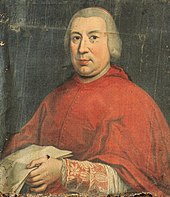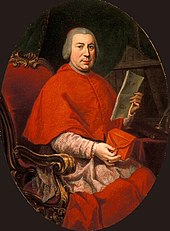Antonio Casali
Antonio Casali (born May 25, 1715 in Rome , † January 14, 1787 ibid) was a Curia Cardinal of the Roman Church .
Live and act
Antonio Casali was born as the second of seven children to the Italian nobleman Giovanni Battista Casali, Marquis of Postina and his wife Maria Magdalena nee. Mellini (often also Millini). On the part of his mother, he was the great-nephew of Cardinal Savo Millini (1644-1701) and the nephew of Cardinal Mario Millini (1677-1756).
From 1725 he studied at the Collegio San Carlo in Modena , later returned to Rome and acquired the degree of Doctor iuris utriusque (secular and spiritual law). The young nobleman felt no vocation to the priesthood, however, came in 1742 as a lay person in the management of the Curia and the Papal States , where he quickly rose as a result of his own talent and protection of relatives and acquaintances. Casali worked in the Roman Curia as a lay prelate without religious ordination and was primarily concerned with caring for the poor in the city of Rome. In November 1761 he became secretary of the Congregation Consulta , main authority of the secular government of the Papal States, on September 26, 1766 Apostolic Protonotary , Vice- Camerlengo (Deputy Head of the Apostolic Chamber ) and Governor of the City of Rome. Pope Clement XIV created Casali as cardinal in pectore on December 12, 1770 , which he published in the consistory of March 15, 1773. In April 1773 Neukardinal seized from its assigned title Diakonie San Giorgio in Velabro possession, which he held until the 1777th Pope Pius VI appointed him in February 1777 cardinal deacon of the Church of Santa Maria ad Martyres (better known under the profane name Pantheon ). In his high position, he reformed and tightened the administrative processes of the papal government, took care of the needy, ensured that prisoners were treated more humanely and founded the Conservatorio di San Pietro textile factory in Montorio .
On March 26, 1773, Casalis was appointed prefect (head) of the Congregation of Good Government , which primarily looked after the budgets of the communes of the Papal States. In the same year he became a member of a commission headed by Cardinal Mario Marefoschi Compagnoni , which was supposed to supervise the dissolution of the Jesuit order . Here he moderated himself in favor of the Jesuits held captive in Castel Sant'Angelo .
Antonio Casali participated in the conclave 1774-1775 , the Pope Pius VI. chose. Even under his pontificate he remained a sought-after administrative specialist who carried out a tax reform and made a name for himself in the trade and road construction industry.
The cardinal was interested in history and archeology all his life. So he discovered the Ara Casali named after him , an ancient altar with Roman-Trojan depictions, which he left to the church and which today is one of the special pieces in the Vatican Museums . On one of his estates at the Porta San Sebastiano he found a precious Roman sarcophagus, which he gave Pope Pius VI. and plaster casts of his figurines were exhibited in Berlin. The original sarcophagus, called Casali sarcophagus , is now in the Ny Carlsberg Glyptotek in Copenhagen , as it was acquired by the brewer and art collector Carl Jacobsen in Rome in 1883.
Antonio Casali suffered from gout in old age. After his death he was buried in the church of Sant'Agostino in Rome, where the family burial is located.
literature
- Political journal; together with an advertisement of learned and other things , year 1787, volume 1, obituary on pages 478–481, digitized in the Google book search
Web links
- Casali, Antonio. In: Salvador Miranda : The Cardinals of the Holy Roman Church. ( Florida International University website), accessed July 26, 2016.
- Coin issued as governor of Rome during the sedis vacancy of 1769 (2nd coin shown)
- Illustrated website about the Casali Sarcophagus in Copenhagen
- Detail of the Casali sarcophagus in Copenhagen
Individual evidence
- ↑ Millini, Savo. In: Salvador Miranda : The Cardinals of the Holy Roman Church. ( Florida International University website , English)
- ↑ Millini, Mario. In: Salvador Miranda : The Cardinals of the Holy Roman Church. ( Florida International University website , English)
- ^ Continued new genealogical-historical news of the most distinguished events that happened at the European courts. Volume 73, Leipzig 1773, p. 97, digital scan of the contemporary report on the cardinal's survey (with notes on the person) in the Google book search
- ^ Hanns Gross: Rome in the Age of Enlightenment. Cambridge University Press, 2004, p. 97, ISBN 0-52-189378-X , scan for the Conservatorio di San Pietro in Montorio in the Google book search
- ↑ Birgit Emich : Territorial Integration in the Early Modern Age: Ferrara and the Papal States. Böhlau Verlag, Cologne and Weimar 2005, p. 70, ISBN 3-41-212705-1 , scan from the source, on the Congregation of the Good Government in the Google book search
- ↑ Website on Ara Casali
- ↑ Karl Friederichs: Berlin's ancient sculptures. 1868, volume 1, p. 480, scan of the discovery of the Casali sarcophagus in Rome in the Google book search
- ^ Baedeker Allianz Travel Guide to Copenhagen. 2009, ISBN 3-82-971139-5 , p. 192
- ↑ Ludwig Pollak : Roman Memoirs: Artists, Art Lovers and Scholars 1893-1943. 1994, ISBN 8-87-062863-9 , p. 90, scan to purchase the Casali sarcophagus 1883 in the Google book search
| personal data | |
|---|---|
| SURNAME | Casali, Antonio |
| BRIEF DESCRIPTION | Cardinal of the Roman Church |
| DATE OF BIRTH | May 25, 1715 |
| PLACE OF BIRTH | Rome |
| DATE OF DEATH | January 14, 1787 |
| Place of death | Rome |

